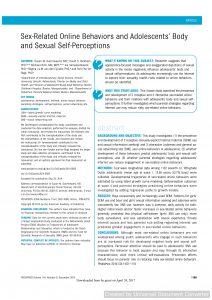Shaping Sexual Behaviors & Sexual Scripts
Sex-Related Online Behaviors and Adolescents’ Body and Sexual Self-Perceptions
 Full Article Name: Sex-Related Online Behaviors and Adolescents’ Body and Sexual Self-Perceptions
Full Article Name: Sex-Related Online Behaviors and Adolescents’ Body and Sexual Self-Perceptions
Open Access: No
Abstract
METHODS: Four-wave longitudinal data among 1132 seventh- to 10th-grade Dutch adolescents (mean age at wave 1: 13.95 years; 52.7% boys) were collected. Developmental trajectories of sex-related online behaviors were estimated by using latent growth curve modeling. Self-perception outcomes at wave 4 and parental strategies predicting online behaviors were investigated by adding regression paths to growth models.
RESULTS: Boys occasionally and increasingly used SEIM. Patterns for girls’ SEIM use and boys’ and girls’ sexual information seeking and cybersex were consistently low. SNS use, however, was a common, daily activity for both. Higher initial levels and/or faster increases in sex-related online behaviors generally predicted less physical self-esteem (girls’ SNS use only), more body surveillance, and less satisfaction with sexual experience. Private Internet access and less parental rule setting regarding Internet use predicted greater engagement in sex-related online behaviors.
Doornwaard, S. M., Bickham, D. S., Rich, M., Vanwesenbeeck, I., van den Eijnden, R. J. J. M., & ter Bogt, T. F. M. (2014). Sex-related online behaviors and adolescents’ body and sexual self-perceptions. Pediatrics December 2014, 134(6), 1103-1110. www.pediatrics.org/cgi/doi/10.1542/peds.2014-0592
